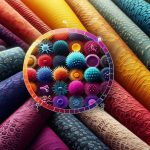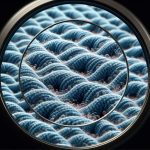You may not realize it, but the chemical properties of fabrics play a crucial role in determining their performance and suitability for various applications. Understanding these properties is essential for anyone seeking mastery in the textile industry.
The top 5 chemical properties of fabrics that you should be familiar with are absorbency, durability, flammability, antimicrobial properties, and colorfastness. Each of these properties can significantly impact the functionality and longevity of fabrics in diverse settings.
By gaining a comprehensive understanding of these chemical properties, you can make informed decisions when selecting fabrics for specific purposes and ensure the desired outcomes.
Key Takeaways
- Absorbency determines how well fabrics can soak up and hold onto liquids. Fabric structure and composition play a significant role in absorbency.
- Durability is crucial for long-lasting and resilient fabrics. Fabric strength, tensile strength, abrasion resistance, pilling resistance, tear strength, and seam strength are factors to consider.
- Flammability testing assesses fire resistance and safety of fabrics, including ignition time, flame spread, heat release rate, and smoke and toxic gas emission.
- Fabrics with antimicrobial properties prevent the growth of microorganisms, contribute to odor control, and help maintain a clean and hygienic environment. Ongoing research aims to enhance the effectiveness and durability of antimicrobial treatments.
Absorbency
When you're evaluating the absorbency of fabrics, you want to consider how well they can quickly soak up and hold onto liquids. Moisture retention is a critical factor in determining the effectiveness of a fabric in various applications.
The fabric structure plays a key role in determining its absorbency. Fabrics with a looser weave or knit tend to have higher absorbency as they provide more spaces for liquid to be held. On the other hand, fabrics with a tighter weave or knit have lower absorbency as there are fewer spaces for liquid retention. Understanding fabric structure is essential in selecting the right material for specific purposes.
Additionally, the composition of the fabric also influences its absorbency. Natural fibers like cotton and linen are known for their high absorbency, while synthetic fibers like polyester and nylon have lower absorbency. It's important to consider these factors when choosing fabrics for applications where moisture retention is crucial.
Durability
The absorbency of fabrics is influenced by their fabric structure and composition, and now, let's delve into the durability of different fabrics. Durability is a crucial aspect of fabric performance, especially for applications requiring long-lasting and resilient materials. Fabric strength and durability are determined through rigorous testing methods, ensuring that the material can withstand various stressors and maintain its integrity over time.
To provide a comprehensive understanding, the table below outlines the durability testing methods and the fabric strengths of different materials:
| Durability Testing | Fabric Strength |
|---|---|
| Tensile Strength | Cotton: High |
| Abrasion Resistance | Wool: Moderate |
| Pilling Resistance | Polyester: High |
| Tear Strength | Silk: Moderate |
| Seam Strength | Nylon: High |
Durability testing involves subjecting fabrics to conditions that simulate wear and tear, such as stretching, abrasion, pilling, tearing, and seam strength evaluation. Understanding the fabric strengths and performance under these tests is essential for selecting the most suitable material for specific applications.
Flammability
To assess the flammability of fabrics, you should utilize standardized testing methods to determine their fire resistance and potential to ignite and sustain combustion. Flammability testing is crucial in evaluating the safety of fabrics, especially in industries such as apparel, furniture, and automotive where the risk of fire is a concern.
Here are four key aspects to consider when evaluating the flammability of fabrics:
- Ignition Time: This measures how long it takes for a fabric to ignite when exposed to a flame. Fabrics with longer ignition times are considered more fire-resistant.
- Flame Spread: This evaluates how quickly a flame spreads across the fabric's surface. Lower flame spread indicates better fire resistance.
- Heat Release Rate: This measures the amount of heat released by a fabric when it burns. Fabrics with lower heat release rates are generally safer in case of fire.
- Smoke and Toxic Gas Emission: Assessing the amount of smoke and toxic gases released during combustion is crucial as these by-products can pose serious health risks in fire situations.
Understanding these aspects through flammability testing helps in identifying and utilizing fire-resistant fabrics, thereby enhancing safety in various applications.
Antimicrobial Properties
Ensuring your fabric's resistance to microbial growth is essential for maintaining product hygiene and longevity. Antimicrobial properties in fabrics are crucial for preventing the growth of microorganisms, such as bacteria and fungi, which can cause odor, staining, and deterioration of the material. Textile engineering plays a pivotal role in integrating antimicrobial features into fabrics, utilizing various techniques such as applying antimicrobial finishes or incorporating antimicrobial agents during the fiber production process.
Odor control is a key benefit of fabrics with antimicrobial properties. By inhibiting the growth of odor-causing bacteria, these fabrics help to keep products smelling fresh even after prolonged use. Moreover, antimicrobial textiles contribute to maintaining a clean and hygienic environment, making them ideal for applications in healthcare, sportswear, and protective clothing.
In the realm of textile engineering, ongoing research and development are focused on enhancing the effectiveness and durability of antimicrobial treatments, ensuring that these properties remain active throughout the lifespan of the fabric. As a consumer, selecting fabrics with reliable antimicrobial properties is a prudent choice for maintaining product hygiene and longevity.
Colorfastness
Maintaining colorfastness is crucial for preserving the vibrancy and appearance of your fabrics, preventing fading and ensuring long-lasting visual appeal. When it comes to colorfastness, there are several important considerations to keep in mind:
- Fabric Dyeing Techniques: Understanding the dyeing techniques used for different types of fabrics is essential for ensuring colorfastness. Whether it's yarn dyeing, piece dyeing, or garment dyeing, the method employed can significantly impact the fabric's ability to retain its color over time.
- Environmental Impact: The chemicals and processes involved in fabric dyeing can have a substantial environmental impact. From water consumption and chemical waste to energy usage, it's crucial to consider the environmental implications of dyeing techniques when aiming for colorfastness.
- UV Protection: Fabrics that are exposed to sunlight need to possess colorfastness against UV rays to prevent fading. Incorporating UV-protective agents during the dyeing process can enhance the fabric's ability to withstand prolonged exposure to sunlight.
- Care Instructions: Proper care and maintenance play a significant role in maintaining colorfastness. Following the recommended care instructions, including washing and storage guidelines, can help preserve the fabric's vibrant colors for an extended period.
Frequently Asked Questions
What Are the Environmental Impacts of the Chemicals Used in Fabrics for Their Antimicrobial Properties?
To minimize environmental impact, consider chemical alternatives for fabric antimicrobial properties. Assessing the life cycle of these chemicals and their potential effects on ecosystems is crucial. Explore sustainable options to mitigate adverse environmental consequences.
How Do Different Fabric Treatments for Colorfastness Affect the Overall Durability of the Fabric?
Colorfastness treatments can improve fabric durability by preventing color fading. Chemical treatments, while enhancing color retention, can have varying environmental impacts. Consider eco-friendly options to minimize negative effects on the environment while maintaining fabric quality.
Are There Any Natural Alternatives to Chemical Treatments for Flammability in Fabrics?
You can explore natural alternatives for flammability treatments in fabrics. Consider using materials like wool, silk, and certain plant-based fibers, which have inherent fire-resistant properties, to reduce the need for chemical treatments.
Can the Antimicrobial Properties of Fabrics Be Affected by Frequent Washing?
Frequent washing can affect the antimicrobial properties of fabrics. Higher temperatures and harsh detergents can decrease effectiveness. This can impact the durability of fibers, leading to reduced antimicrobial performance over time.
How Do Different Dyeing Techniques Impact the Colorfastness of Fabrics?
Different dyeing techniques can impact colorfastness. Chemical reactions in dyeing processes alter fabric properties, affecting color retention. Understanding these interactions empowers you to choose the best dyeing method for durable, vibrant fabrics.
- 3D Printed Textiles: Opportunities and Challenges - July 24, 2024
- Laser Engraving Techniques for Fabric Designers - July 24, 2024
- Digital Fabric Printing: Trends and Innovations - July 24, 2024








